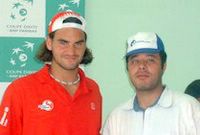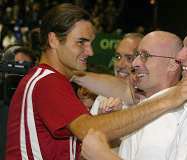Let's face it - clay court tennis is different than hard court tennis.
And it's arguably more fun, more athletically challenging, and more stylish allowing you more time to hit beautiful angles.
And, as tempting as it is to try and play the same patterns on clay that you play on hard court, sometimes your old standby hard court patterns and tactics just don't work as well on clay.
For example, on hard court, a big inside out forehand can hurt your opponent and the point can often be won on the next shot with either another inside out or an inside in forehand up the line.
On clay your opponent can usually return your first inside out forehand without any trouble. so to hurt your opponent and gain an advantage you have to be more patient and hit a number of inside out forehands sometimes trying to pull your opponent wide further and further off the court. Then, when the opening is there you can go inside in up the line.
Watch the rallies on clay now and observe the patterns the players use . You'll notice how they're much more patient than on hard court.
Until next time,
Glenn Sheiner M.D. Author of INSIDER TENNIS STRATEGIES the tennis Ebook that can make you a smarter player and help you to win more matches now.
Tuesday, April 26, 2005
Saturday, April 16, 2005
Playing hard court tennis on the clay
Saw a little bit of Federer's play this week at Monte Carlo. He's always a treat to watch but it struck me that he's still trying to play hard court tennis on the red clay.
He's chipping and charging, serving and volleying and hitting big shots and following them to the net --all classic hard court tactics.
But these tactics are less successful on clay because his opponents have time to track down his shots and set up to pass. So his winning efficiency goes down .
That's why I think he'll have trouble winning in Paris.
Until next time,
Glenn Sheiner M.D. author of INSIDER TENNIS STRATEGIES The tennis Ebook guaranteed to make you a better player.
He's chipping and charging, serving and volleying and hitting big shots and following them to the net --all classic hard court tactics.
But these tactics are less successful on clay because his opponents have time to track down his shots and set up to pass. So his winning efficiency goes down .
That's why I think he'll have trouble winning in Paris.
Until next time,
Glenn Sheiner M.D. author of INSIDER TENNIS STRATEGIES The tennis Ebook guaranteed to make you a better player.
Wednesday, April 13, 2005
Federer vs Nadal -- A lesson in tactics
What a match. Federer versus Nadal in the finals of the Nasdaq 100. Nadal is a superstar in the making with power,speed, grit, and incredible shotmaking ability.
But--and there's usually a but -- Nadal's style of play and his tactics make him susceptible to fatigue just as you saw in the finals versus Federer as he had nothing left for the last 2 sets.
Nadal plays way behind the baseline which means he has to run great distances to get to balls and then has to hit them with full force to get them back deep and with heavy spin. So, while it looks spectacular and can be impossible to defeat, it is so draining physically that it's almost guaranteed that Nadal will slow down as a match progresses.
Plus Nadal merely spins his first serve in so he gets no free points there either.
Bottom line -- Nadal needs to improve his first serve and also learn to try and end some point earlier by standing closer to the baseline. Then, when he really needs to grind it out in a 5th set he'll have some energy left.
Until next time,
Glenn Sheiner -- author of INSIDER TENNIS STRATEGIES The tennis Ebook that can improve your game immediately.
But--and there's usually a but -- Nadal's style of play and his tactics make him susceptible to fatigue just as you saw in the finals versus Federer as he had nothing left for the last 2 sets.
Nadal plays way behind the baseline which means he has to run great distances to get to balls and then has to hit them with full force to get them back deep and with heavy spin. So, while it looks spectacular and can be impossible to defeat, it is so draining physically that it's almost guaranteed that Nadal will slow down as a match progresses.
Plus Nadal merely spins his first serve in so he gets no free points there either.
Bottom line -- Nadal needs to improve his first serve and also learn to try and end some point earlier by standing closer to the baseline. Then, when he really needs to grind it out in a 5th set he'll have some energy left.
Until next time,
Glenn Sheiner -- author of INSIDER TENNIS STRATEGIES The tennis Ebook that can improve your game immediately.
Wednesday, April 6, 2005
A quantum leap in my tennis confidence
Wow. I recently took a set off the number 1 player in canada in the 50-55 age group. I'm 49 so I'm getting close.
This was by far my biggest set win in my life and although I lost the match it validated a lot of the work I've been doing on my game and my tactical approach.
How I'd do it? I served big and well. More interestingly, I noticed a few patterns that were working to my advantage and I kept on using them.
For example, I noticed that my hard flat serve to the backhand wasn't giving my opponent trouble . He was able to block them back with a short slice backhand stroke. But ,when I hit hard kick on the first serve the height of the bounce surprised him and he made mistakes.
Also I noticed he was vulnerable to a really tough slice serve so I really went after my slice to give it a mean curve after the bounce.
My confidence that I can take a set off anybody is now sky high. Can't wait for the next tournament.
Until next time,
Glenn, Author of INSIDER TENNIS STRATEGIES The tennis Ebook that can take you from losing to winning in a day.
This was by far my biggest set win in my life and although I lost the match it validated a lot of the work I've been doing on my game and my tactical approach.
How I'd do it? I served big and well. More interestingly, I noticed a few patterns that were working to my advantage and I kept on using them.
For example, I noticed that my hard flat serve to the backhand wasn't giving my opponent trouble . He was able to block them back with a short slice backhand stroke. But ,when I hit hard kick on the first serve the height of the bounce surprised him and he made mistakes.
Also I noticed he was vulnerable to a really tough slice serve so I really went after my slice to give it a mean curve after the bounce.
My confidence that I can take a set off anybody is now sky high. Can't wait for the next tournament.
Until next time,
Glenn, Author of INSIDER TENNIS STRATEGIES The tennis Ebook that can take you from losing to winning in a day.
Tuesday, April 5, 2005
Pavel Kovac
 Czech physiotherapist Pavel Kovac travels with Roger on occasions.
Czech physiotherapist Pavel Kovac travels with Roger on occasions.Roger's comments about Kovac:
Q. How much did Czech fitness trainer Pavel Kovac help you?
Federer: Well, he's been traveling with me for over a year now. It's a pleasure to work with him. He's a very nice guy. Looking forward to work with him in the future, as well, because he did a good job.
Source Interview

Pierre Paganini
 Pierre Paganini, a former athlete and soccer player, is the fitness trainer (condition coach) for Roger as well as for Swiss Davis Cup team. His contact info.
Pierre Paganini, a former athlete and soccer player, is the fitness trainer (condition coach) for Roger as well as for Swiss Davis Cup team. His contact info.- One of his rare interviews. [in German, English version]
- Tennis Magazine's article on Pierre Paganini.
- Video Clip of an Interview [in French, Real Media][Transcript in English]



His comments on Roger:
Paganini has been helping Federer make tennis look easy for the last 10 years and together they put in 100 hours of fitness training throughout the season, either at tournaments or when Federer is at home in Switzerland. They do a combination of strength and endurance work, circuit training, running and a wide range of exercises designed to practice all the movements Federer is likely to make on a tennis court.Source
Prior to a big tournament they will work for 10 hours a week or more, depending on the surface he is going to play on, but Paganini says he never hears so much as a murmur of fuss from Federer. "Roger is a pleasure and a privilege to work with," said Paganini. "He never complains about having to work hard as long as he understands why he is doing it. He asks me what we are doing and why and then he gets to work. He knows that he is talented and that the fitness work we do is going to bring that talent through. "He's always been the same. You can have all the shots but if you aren't there in time it doesn't matter and Roger knows that. Even when I am really tough on him he never stops working and he never wants to stop. That's the kind of man he is and that's why he is a champion. He really is an amazing person."
Subscribe to:
Comments (Atom)

